
Outdoor Research Ferrosi Summit Hooded Jacket
Reviewer: 5’11”, 160 lbs
Size Tested: Medium
Stated Weight (size Large): 525 grams
Measured Weight (size Medium): 485 grams
Stated Center Back Length: 76 cm / 30 in
Materials:
- Body: Cordura®, 91% nylon, 9% spandex 120D stretch woven
- Underarm and lower hood panels: 86% nylon, 14% spandex 90D stretch woven ripstop
Stated Features:
- Fabric Performance: Water-resistant, wind-resistant, abrasion-resistant, breathable, hybrid mapped construction, quick-drying, lightweight, movement-mirroring stretch
- Design Features: Helmet compatible wire-brimmed halo-hood, zip chest pockets, zip hand pockets, YKK® DWR-treated zippers, integrated hood cordlocks, key clip
- Functional Details: Dynamic Reach™ underarm panels, single-separating front zipper, pocket placement above harness, stretch panel at base of hood, hook/loop cuff closure drawcord hem
Pockets:
- Two chest pockets (zippered)
- Two hand pockets (zippered)
MSRP: $165
Test Locations: Beartooth Mountains, Bridger Range, & Hyalite Canyon, MT
Days Tested: 25
Intro
The original Outdoor Research Ferrosi hoody has been a staple piece for many climbers, skiers, and general outdoor enthusiasts for years. Since the release of the Ferrosi hoody, Outdoor Research has expanded it to an entire Ferrosi line of lightweight, breathable layers ranging from shorts to hats and of course, jackets.
The Ferrosi Summit Jacket is a beefed-up addition to the family, bridging the gap between a lightweight soft shell and a fully waterproof hard shell. By using Cordura in the main fabric, Outdoor Research claims to have improved durability without significantly affecting weight or breathability. So are they right?
Fit
At 5’11”, 160lbs, I’ve worn a size Medium in almost every single upper body layer I’ve used. I have long arms and a fairly standard torso length. One aspect of Outdoor Research’s clothing that I’ve often appreciated is that the brand’s cuts tend to err on the longer, slender side, which generally translates to an excellent fit for my body. I found the Ferrosi Summit to follow this trend with a longer-than-normal torso and sleeves. The Ferrosi Summit’s sleeves didn’t ride up on my arms, even when I reached high to swing ice tools, and the back of the jacket stayed put underneath a harness.
Somewhat surprisingly, I felt like I could plausibly have worn a size Small in the Ferrosi Summit Jacket. The chest is cut larger than other soft shells I’ve worn which allows for easy layering underneath, but excess fabric when layered over just a t-shirt. For comparison, I think the Ferrosi Summit’s chest is cut larger than the standard Outdoor Research Ferrosi Jacket, Mammut Eisfeld Light SO Hoody, and the Black Diamond Alpine Start Hoody. After trading jackets for the day with a 6’2” climbing partner (who typically wears a size Large), he noted how well the size Medium Ferrosi Summit fit him.
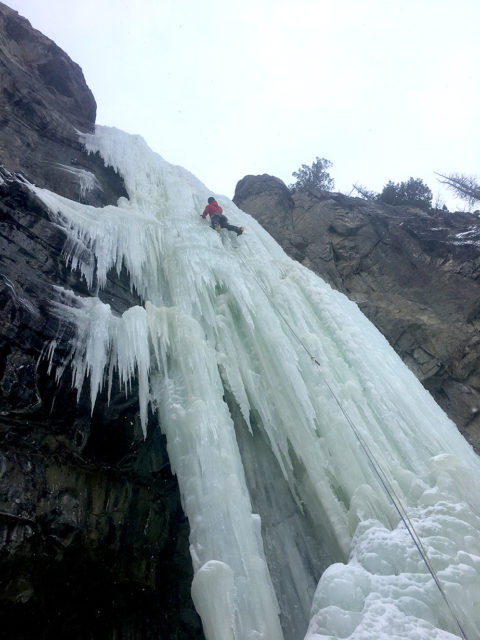
It’s hard to say if a Small would fit me better, but my hunch is that the size Small would have fit closer to a “normal” size Medium. But if you occasionally find yourself caught between sizes, it’s likely worth trying to find both sizes of the Ferrosi Summit to try on and compare.
Materials
Outdoor Research does not give the soft shell fabric used on the Ferrosi Summit a specific name besides stating that the body fabric is woven with Cordura for added durability. For comparison, the Ferrosi Summit’s fabric is heavier than that used on the Black Diamond Alpine Start Hoody but feels lighter than the fabric of the Patagonia Knifeblade Jacket or the Arc’teryx Gamma MX.
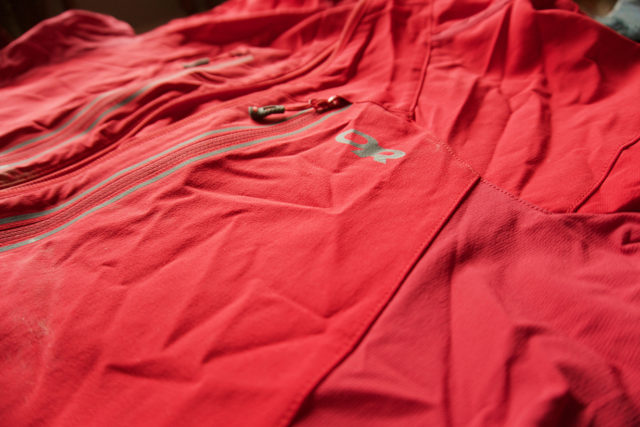
It’s worth noting that Outdoor Research uses two different fabrics on different parts of the Ferrosi Summit jacket. The torso, sleeves, and hood are constructed with a 120-denier 91% Cordura nylon / 9% spandex blend while the underarms and lower hood are made from 90-denier 86% nylon / 14% spandex blend. Outdoor Research calls this layout “Hybrid Mapping.” I found the increased stretch of the underarms and hood helped increase the mobility of the jacket. On the flip side, I could feel a noticeable difference in the wind and water resistance of the Hybrid Mapped panels, especially under the arms (this is the darker red fabric in the photos above and below).

I found the Ferrosi Summit’s fabric to be exceptionally soft for being so durable. It’s quite comfortable even when worn directly over a t-shirt. The fabric feels closer in softness and comfort to a synthetic long-sleeve t-shirt than a standard soft shell or windshirt.
Features
Pockets
The Ferrosi Summit has four pockets: two hand pockets near the hem and a pair of chest pockets. All the pockets are cavernous and I was easily able to fit a pair of gloves, snacks, and a phone in them simultaneously with room for a lot more. Granted, stuffing that much in my pockets wasn’t exactly comfortable, but such are the minor discomforts of gear testing.
For extra ventilation, the interior of each pocket is constructed with nylon mesh which allows additional airflow when the pockets are unzipped. With nothing in the pockets, I liked this feature and wished that I could leave the pockets open all the time when moving uphill. That said, the fabric breathes well enough that I didn’t feel the extra ventilation was necessary except in the most strenuous moments, like when skinning uphill.
I do wish the hand pockets were positioned slightly higher on the jacket as they get covered when wearing a harness. That said, the pockets’ construction is low-profile enough that I didn’t notice them digging into my hips while wearing a harness. On the other hand, the chest pockets are positioned high and close to the main zipper of the jacket, so they remain accessible when wearing a backpack.
Hood
Like the pockets, the hood on the Ferrosi Summit is gigantic and fits over a climbing helmet with space to spare. I also wore the hood over a ski helmet, and while the Ferrosi Summit’s hood isn’t quite as big as one found on most dedicated ski-touring jackets, it fit over a bulkier ski helmet comfortably. It’s also flexible enough to allow me to turn around and look at the beautiful mountains.
I occasionally found the hood to be too large to wear comfortably without a helmet, but that’s a trade-off I’ll happily take in exchange for being able to batten down the hatches when actually climbing with a helmet.
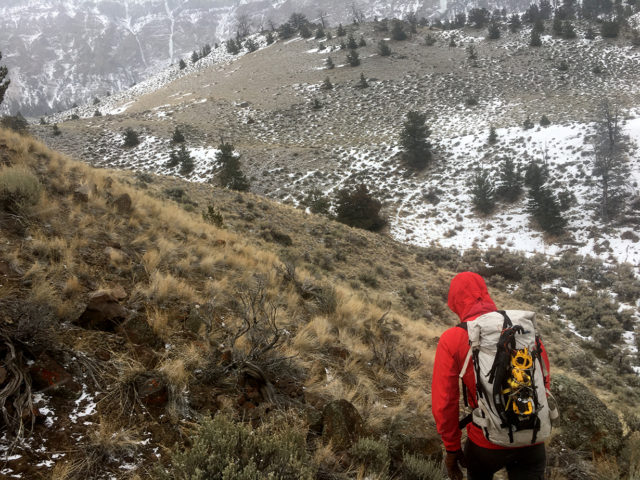
And while the hood is large, it does have an elastic drawcord around the circumference to cinch tight around a bare head and a pair of drawcords at the cheeks to pull in the sides, which both work well to keep the hood from blowing off in gusty conditions. With both sets of drawcords fully cinched, the hood stayed in place over a bare head, but because the hood is so big, I still ended up with the fabric somewhat annoyingly bunched around my ears.
Weather Resistance
It’s natural for me to want to compare the Ferrosi Summit to a jacket like the Patagonia Knifeblade as they are both alpine-oriented soft shells of similar weights, but I think that comparison is unfair to both jackets. Where the Knifeblade provides near-hard-shell levels of weather protection, the Ferrosi Summit is made from a more breathable material that does better with higher-exertion activities, but does so at the expense of weather resistance.
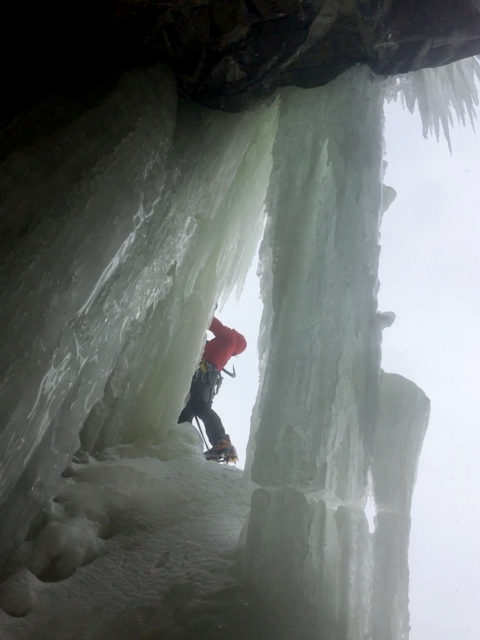
Outdoor Research says the Ferrosi Summit is designed to “provide abrasion resistance while shrugging off wind and light rain.” Based on my experience, I think a better niche to place the jacket in is between a minimal windshirt like the Black Diamond Alpine Start Hoody and a very weather-resistant jacket like the Knifeblade or a lightweight hard shell.
The Ferrosi Summit does not have taped seams or a waterproof zipper like those that are commonly found on hard shells or extraordinarily weather-resistant soft shells. But compared to the Black Diamond Alpine Start and the original Outdoor Research Ferrosi Jacket, the Ferrosi Summit Jacket was significantly more weather-resistant.
I wore the Ferrosi Summit on an early season ice climb in the Beartooth Mountains, MT where my partner and I groveled our way up thin ice and mossy chimneys while getting a constant stream of spindrift and dripping (okay — running) water. Before I entered the waterfall pitch, the Ferrosi Summit Jacket did an excellent job of keeping my body dry and free of the spindrift pouring down onto my head. Although I was pretty wet after the waterfall, the jacket dried quickly and still kept me shielded from the wind whipping across the summit plateau.
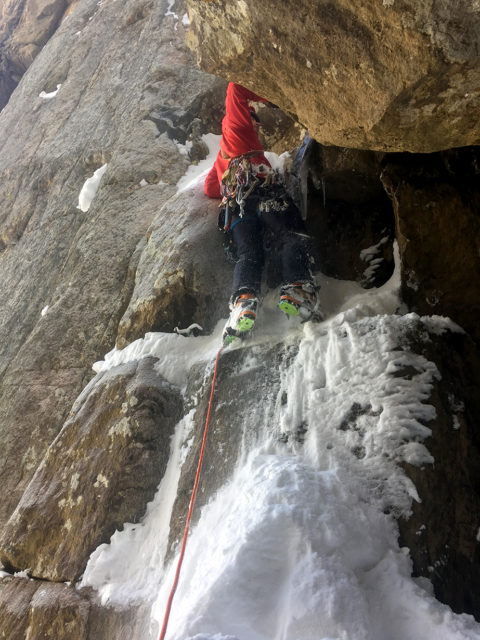
On the flip side, I also wore the Ferrosi Summit Jacket while teaching an avalanche course in a wet, early-season snowstorm and regretted my decision as the jacket soaked through quickly once I stopped moving. But as we toured up at the beginning of the day, I was able to maintain a comfortable temperature wearing the jacket, even in heavy snow. While skinning I did notice some ‘wetting out’ of the fabric on my sleeves and shoulders, but the torso stayed relatively dry.
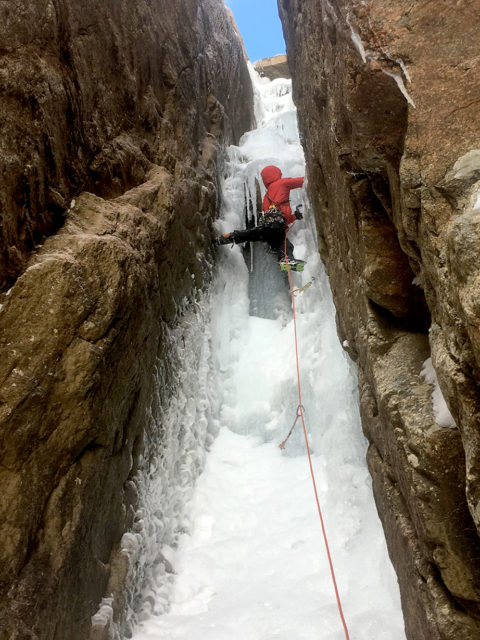
If expecting bad weather, I would not take the Ferrosi Summit as my sole piece of weather protection. I think the Ferossi Summit is best as an outer layer for cold, dry, windy days in the winter where the main concerns are maintaining dexterity with multiple layers as well as protection from wind and spindrift, but not full-on precipitation.
Breathability
Between the large pocket vents and unlined fabric, the Ferrosi Summit Jacket breathes very well when worn during periods of high exertion. At the same time, that breathability results in a lack of warmth when worn at times of rest. I found myself getting colder, faster when wearing the Ferrosi Summit compared to when I was wearing the Knifeblade.
I was able to move comfortably in the Ferrosi Summit in temperatures up to around freezing, at which point I started sweating out. Below freezing, or in any substantial wind, I didn’t feel the need to slow my pace or remove the Ferrosi Summit to keep from sweating.
Durability
As stated above, the fabric on the Ferrosi Summit is remarkably durable despite its soft hand. I wore the jacket for many days of ice- and mixed-climbing, and after scratching my way up icicles and choss, it doesn’t look any worse for the wear. Even the shoulders, which typically wear the fastest on my jackets, look almost new. I also haven’t had any durability issues with the hardware (zippers, elastic pulls) on the jacket. I’ll update this review if any durability issues come up in the future.
Bottom Line
The Outdoor Research Ferrosi Summit Jacket fills a niche between a light, wind-resistant soft shell and a waterproof hard shell. I think the Ferossi Summit performs best as a layer for cold, windy, but generally dry days of ice and mixed climbing or backcountry skiing. Its fabric provides good wind resistance and enough water resistance to shrug off spindrift and snow. All of this makes the Ferossi Summit Jacket a pretty versatile soft shell for cool and cold activities where breathability, durability, and range of motion are key.
